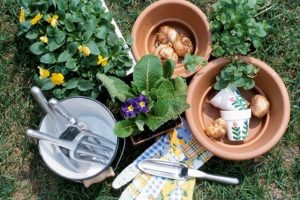Mother Nature has created a February of warm spring weather, making gardeners put down their worn seed catalogs and grab their shovels. The one thing all gardeners know is that it all starts with a seed.
When spring hits full blown, every nursery will be well stocked with seedlings. So why be concerned about seeds and starting your own plants? The economics of seed starting is money smart. By starting your own plants you will achieve a bigger yield for the money. One package of seeds gives enough plants for repeat continuous planting through the season and enough to share with the neighbors. The selection is huge for almost any plant. You will find varieties that are new, vintage, different colors and sizes. It is possible to get lost and confused with the choices of tomatoes alone!
The reward from starting seeds yourself is healthier, stronger plants. By following the instructions on the seed packet – appropriately watering, applying enough light and heat, providing the correct amount of fertilizer, and using the right planting mix – you will have a super strong plant.
Seed starting invites the group activity of seed swapping. How many red zinnia seeds do you need from your seed packet? Frequently seeds are sold by the ounce so light weight seeds will create far more plants than you want or need. Sharing seeds leads to sharing knowledge and achieving success.
How do you choose what to plant? Your weekly trip for grocery shopping will help make your list of seeds. Comparing prices on vegetables and herbs will help in the decision making. The favorite spring plants for vegetables are tomatoes. Depending on the variety, one plant over a growing season will produce 10 to 30 pounds of tomatoes. Leaf lettuce produces throughout the growing season by harvesting the outside leaves then allowing the plant to regrow. Romaine lettuce is the highest yielding variety. A row of 10 plants will provide a family of four with salad every other night for the season. The growing season may be extended by a cold frame or frost cloth. Cucumbers may be trellised, putting 2 to 3 plants in one cage. Each plant may provide 5 to 10 over the season, with even more of the smaller varieties. Specialty peppers are easy to grow and love our summers. Almost any pepper will be a huge savings from the grocery store since they are high yielding and productive. Herbs are expensive in stores and economical to grow at home. Many herbs are perennials and permanent in your garden.
To start your seeds, you have to get the timing right. The seedlings should be ready when the weather is favorable and the soil is warm. Check the seed packets for instructions and timing. Finding the right containers for planting is easy. The container needs to hold 2 to 3 inches deep of planting medium and drain holes. Containers can range from paper cups to yogurt cups to plastic six packs made for seed starting. Use a starting soil that is made for growing seeds. It should be fresh and sterile. Do not use soil from your garden or from old pots. Before adding your seeds, moisten the soil medium. The soil should be moist, but not sopping wet. Fill your containers and press down enough to remove the air gaps. Seed medium has few nutrients so remember to start feeding your plants with a liquid fertilizer a couple of weeks after germination.
The seed packet will advise the depth of the seed application. Some seeds will need light so they would be sprinkled on the top, other will be buried. Plant two seeds to a pot and after germination keep the strongest plant. As seeds grow, water using a mister to a level of moist, not soggy, soil. Set up a fan to provide air movement, prevent disease, and make your plant stronger. Use liquid fertilizer regularly according to the package instructions. Seeds need about 15 hours of light a day. A warm south facing window or growing under light will provide the needed requirements. Remember to gradually move your new seedlings outdoors.
In preparation for the new seed-starting season, join the Master Gardeners on March 3rd from 10:00 to 1:00 at the Cassina Demonstration Garden on open garden day, March 3rd, which is also the opening day for the Seed Library at the Sonora Library. Join the Master Gardeners and let’s talk seeds.
Julie Silva is a University of California Cooperative Extension Master Gardener of Tuolumne County.
UCCE Master Gardeners of Tuolumne and Calaveras Counties can answer home gardening questions. Call 209-533-5912 or go to: http://ucanr.edu/survey/survey.cfm?surveynumber=7269 to fill out our easy-to-use problem questionnaire. Check out our website at: http://cecentralsierra.ucanr.edu/Master_Gardeners/ You can also find us on Facebook.


